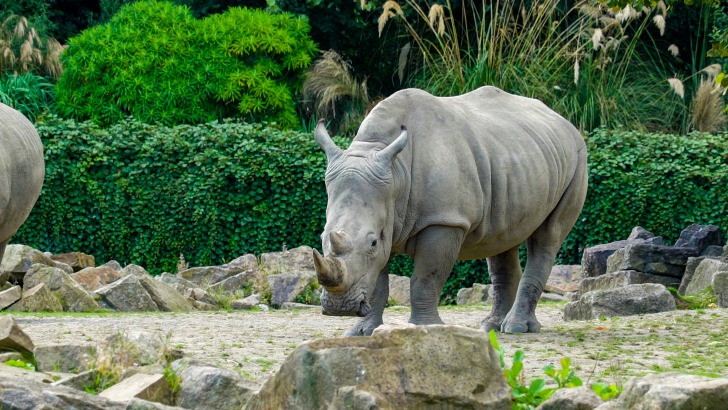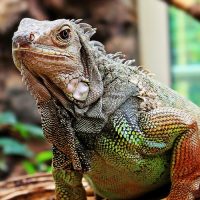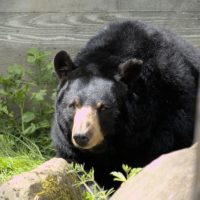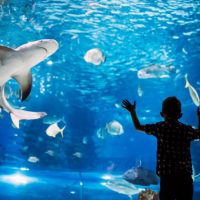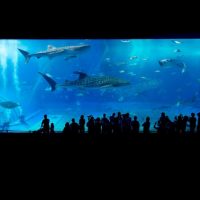North Dakota has a variety of fascinating native animals, including moose, elk, bison, mountain lions, bighorn sheep, and white-tailed deer.
At the range of zoos and aquariums in the state, you can view these creatures alongside other animals from around the world.
The region has beautiful landscapes, and it’s an excellent place for kids and adults to learn about wildlife.
Contents
- Best Zoos & Aquariums in North Dakota
- 1. The Chahinkapa Zoo
- 2. The Dakota Zoo
- 3. The Red River Zoo
- 4. The Roosevelt Park Zoo
- 5. The National Buffalo Museum
- 6. The Garrison Dam National Fish Hatchery
- 7. The Theodore Roosevelt National Park
- 8. The Valley City National Fish Hatchery
- 9. The Audubon National Wildlife Refuge
- 10. The Arrowwood National Wildlife Refuge
- 10 Best Zoos & Aquariums in North Dakota – Summary Table
- North Dakota Safety Overview
- Frequently Asked Questions
Best Zoos & Aquariums in North Dakota
Here are some of the best zoos and aquariums in North Dakota and some answers to FAQs about the state.
1. The Chahinkapa Zoo
The Chahinkapa Zoo is next to Chahinkapa Park in Wahpeton, near the Minnesota border.
It has more than 70 animal species and 200 individuals, including otters, orangutans, snow leopards, American alligators, bison, camels, tigers, and spider monkeys.
This zoo is near the banks of the Red River of the North, and the area has lots of songbirds, waterfowl, and other wildlife.
There’s a campground with two cabins, or you can bring a tent or RV.
There’s also a fun carousel for kids next to the zoo.
You can visit in September and October from 10 a.m. to 4 p.m.
2. The Dakota Zoo
The Dakota Zoo is in Bismarck, North Dakota. It covers 90 acres, and it has more than 600 animals, birds, fish, and reptiles.
You can see Arctic foxes, bearded dragons, bald eagles, bobcats, emus, grizzly bears, prairie dogs, and more.
There’s a play area for kids, a rose garden, a gift shop with lots of fun souvenirs, a concession stand, and an ice cream parlor.
Over 150,000 people visit each year, and the Dakota Zoo is open from 1 to 5 p.m., Friday through Sunday.
From late April through September, it’s open every day from 10 a.m. to 6 p.m.
3. The Red River Zoo
The Red River Zoo is in Fargo, and it focuses on animals from similar climates to North Dakota.
You can see over 75 species, including Chinese red pandas, wolves, camels, and bald eagles.
You and your friends or family members can make a reservation to feed Olivia the porcupine or the red pandas.
The Children’s Zoo Farm has gardens where kids can try farming and several farm animals, including sheep, cows, goats, chickens, alpacas, and a horse.
The Red River Zoo is open every day from 10 a.m. to 5 p.m.
It started in 1993, and it covers 34 acres.
4. The Roosevelt Park Zoo
The Roosevelt Park Zoo is in Minot, a couple of hours away from the Canadian border.
It has 135 animals from 68 species, including African warthogs and penguins, brown bears, zebras, and snow leopards.
There’s a gift shop and feeding stations for the giraffes, sheep, and goats.
This place is open Monday through Saturday from 10 a.m. to 3 p.m. October through April.
In May, you can visit from 9 a.m. to 6 p.m. From June through August, Roosevelt Park Zoo is open until 8 p.m.
In September, you can visit from 10 a.m. to 6 p.m.
5. The National Buffalo Museum
The National Buffalo Museum is in Jamestown, about halfway between Bismarck and Fargo.
It has exhibits about bison biology and physiology, pottery with bison themes, and more.
You can also see two herds of bison outside the museum.
The animals are usually visible from the road, and you can schedule a guided, up-close tour in summer.
The museum is open from March through October, from Monday through Saturday, from 10 a.m. to 5 p.m.
From November through February, it’s closed on Mondays.
From Memorial Day through Labor Day, you can visit from 10 a.m. to 6 p.m. every day.
6. The Garrison Dam National Fish Hatchery
The Garrison Dam National Fish Hatchery is also an aquarium.
It’s in Riverdale, near the Missouri River, and it’s about an hour north of Bismarck.
It has five 400-gallon tanks with a variety of native fish species.
Guided tours are available, and there are over three miles of trails where you can see native birds and other animals.
From Memorial Day through Labor Day, you can visit on weekdays from 8 a.m. to 3:30 p.m. and on weekends from 10 a.m. to 3 p.m.
During other parts of the year, the Garrison Dam National Fish Hatchery is closed on weekends.
7. The Theodore Roosevelt National Park
The Theodore Roosevelt National Park is in southwest North Dakota, and it has a variety of native plants and wildlife.
You can see more than 185 bird species, including golden eagles, great-horned owls, and wild turkeys.
There’s also a herd of over 400 bison, elk, bighorn sheep, a herd of longhorn cattle, and several horses.
In many areas, you can see animals during a drive or hike.
The Little Missouri River goes through the park, and you can see many forests and prairies.
Guided tours are available in summer, and the park is open all year, 24 hours per day.
8. The Valley City National Fish Hatchery
The Valley City National Fish Hatchery is a larger Garrison Dam hatchery subsidiary.
It opened in 1940, and it was originally for breeding bass and bluegill.
It also has Northern pike, walleye, rainbow trout, lake sturgeon, freshwater mussels, and other native species.
There are more than 30 ponds, and kids and adults can have fun fishing, canoeing, and observing local wildlife.
There’s a picnic area and a pollinator garden with more than 50 plant species.
This hatchery is open all year from dawn to dusk. It’s about half an hour east of Jamestown, and admission is free.
9. The Audubon National Wildlife Refuge
The Audubon National Wildlife Refuge covers 14,739 acres.
It includes part of Lake Audubon, prairies, wetlands, and grasslands.
People often call the region the duck factory of North America because many waterfowl breed there.
There are many hiking trails and roads where you can observe wildlife.
You can go ice fishing in winter or fish from the shore during other parts of the year.
The visitor’s center is in Coleharbor, about an hour north of Bismarck, and it’s open on weekdays from 8 a.m. to 4:30 p.m.
It has exhibits about the migratory birds and other animals in the area.
10. The Arrowwood National Wildlife Refuge
At the Arrowwood National Wildlife Refuge, you can see many species of ducks and other waterfowl.
It’s in Pingree, about 20 minutes north of Jamestown.
There’s a 5.5-mile tour route that you can take by car, and there’s an observation deck on the way with a great view of the James River and lots of wildlife.
It’s closed in winter, but you can still go hiking, hunting, snowshoeing, and ice fishing in the area.
The visitor’s center is open on weekdays, and the refuge opens and closes an hour and a half before and after sunrise and sunset.
10 Best Zoos & Aquariums in North Dakota – Summary Table
| Zoos & Aquariums | Address |
|---|---|
| The Chahinkapa Zoo | 1004 Rj Hughes Dr, Wahpeton, ND 58075, United States |
| The Dakota Zoo | 602 Riverside Park Rd, Bismarck, ND 58504, USA |
| The Red River Zoo | 4255 23rd Ave S, Fargo, ND 58104, USA |
| The Roosevelt Park Zoo | 1219 E Burdick Expy, Minot, ND 58701, USA |
| The National Buffalo Museum | 500 17th St SE, Jamestown, ND 58401, USA |
| The Garrison Dam National Fish Hatchery | 530 Hatchery Rd, Riverdale, ND 58565, USA |
| The Theodore Roosevelt National Park | 315 2nd Ave, Medora, ND 58645, United States |
| The Valley City National Fish Hatchery | 11515 River Rd, Valley City, ND 58072, USA |
| The Audubon National Wildlife Refuge | 3275 11th St NW, Coleharbor, ND 58531, USA |
| The Arrowwood National Wildlife Refuge | 7745 11th St SE, Pingree, North Dakota 58476, US |
North Dakota Safety Overview
READ THE FULL REPORT: North Dakota Safety Review
Safety Index:
- OVERALL RISK: LOW
- TRANSPORT & TAXIS RISK: MEDIUM
- PICKPOCKETS RISK: LOW
- NATURAL DISASTERS RISK: LOW
- MUGGING RISK: LOW
- TERRORISM RISK: LOW
- SCAMS RISK: LOW
- WOMEN TRAVELERS RISK: LOW
Frequently Asked Questions
When Did North Dakota Become a State?
North Dakota became a state on November 2, 1889, at the same time as South Dakota.
How Is Transportation in North Dakota?
Many cities in North Dakota offer bus services three to five days per week.
On other days or in rural areas, you can use a taxi or a rideshare service.
The roads are in good condition in most places, and there are several highways.
People who have a valid driver’s license and are 21 years old or over can rent a car, truck, or SUV.
If you drive in winter, it’s a good idea to have snow tires, chains, salt, an ice scraper, and a snow shovel.
North Dakota has several airports, and it’s easy to take an international, local, or regional flight from the state.
A local flight in a small plane is also a great way to view the state’s beautiful landscapes.
What Are the Biggest Cities in North Dakota?
The biggest cities in the state are Fargo, Bismarck, Grand Forks, and Minot.
Fargo is the largest, and Bismarck is the capital.
Are the Northern Lights Visible?
The Northern Lights are often visible in North Dakota, but how well you can see them depends on the local weather and fluctuations in the planet’s magnetic field.
Does North Dakota Have Lots of Farms?
Almost 90% of the land in North Dakota, 39.1 million acres, includes farms and ranches.
The state produces more honey spring wheat, peas, durum wheat, beans, flaxseed, and canola than anywhere else in the country.
It’s easy to find a ranch or farm where you can go horseback riding, spend some time with the animals, and enjoy beautiful landscapes.
The state is also the top sunflower producer in the country, and you can see many fields filled with them in summer.
The canola and flax fields have stunning blooms as well.
What’s Cell Phone Coverage Like in North Dakota?
In most locations, cell phone coverage is good.
The reception is clear, and businesses often offer free Wi-Fi.
However, some rural and forested areas may not have coverage.
When Is the Best Time to Visit North Dakota?
The weather is best in North Dakota during spring, summer, and early fall.
Many zoos and other attractions are open earlier and later during these seasons as well.
In spring, you can often see cute baby animals, and the leaves are beautiful in fall.
Winter in the state is lots of fun as well, but snowstorms can sometimes ruin your plans.
